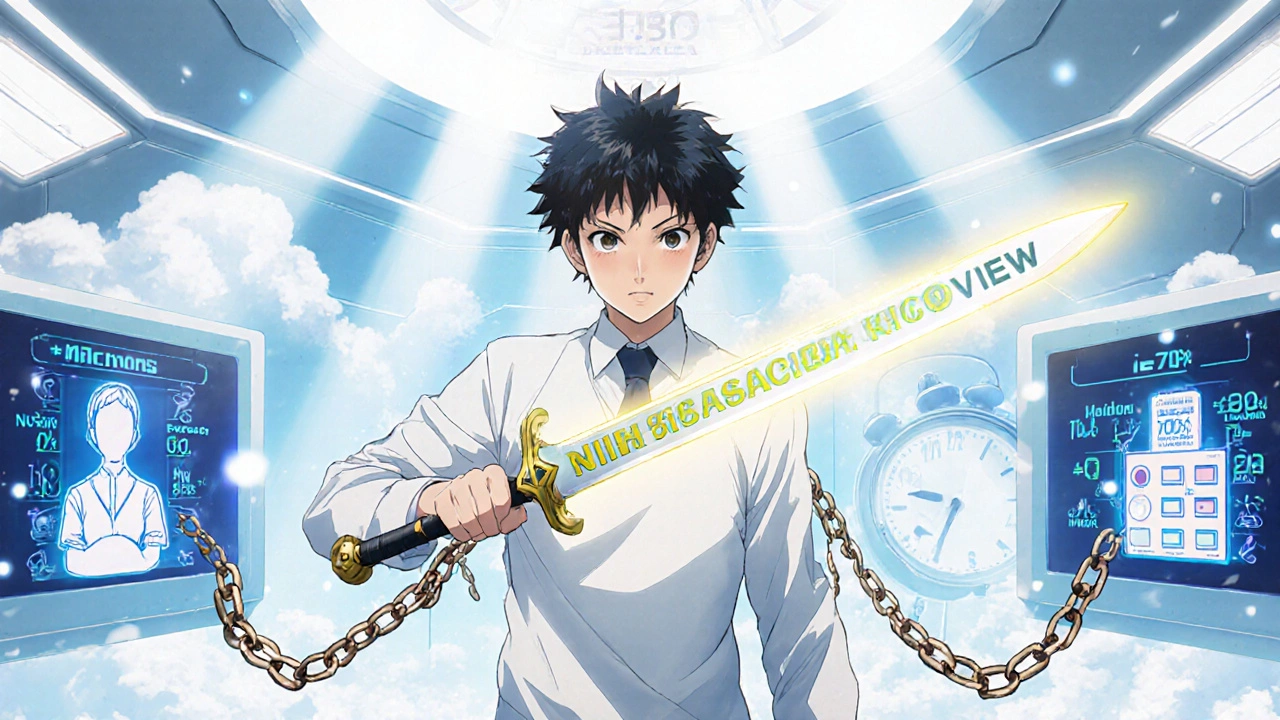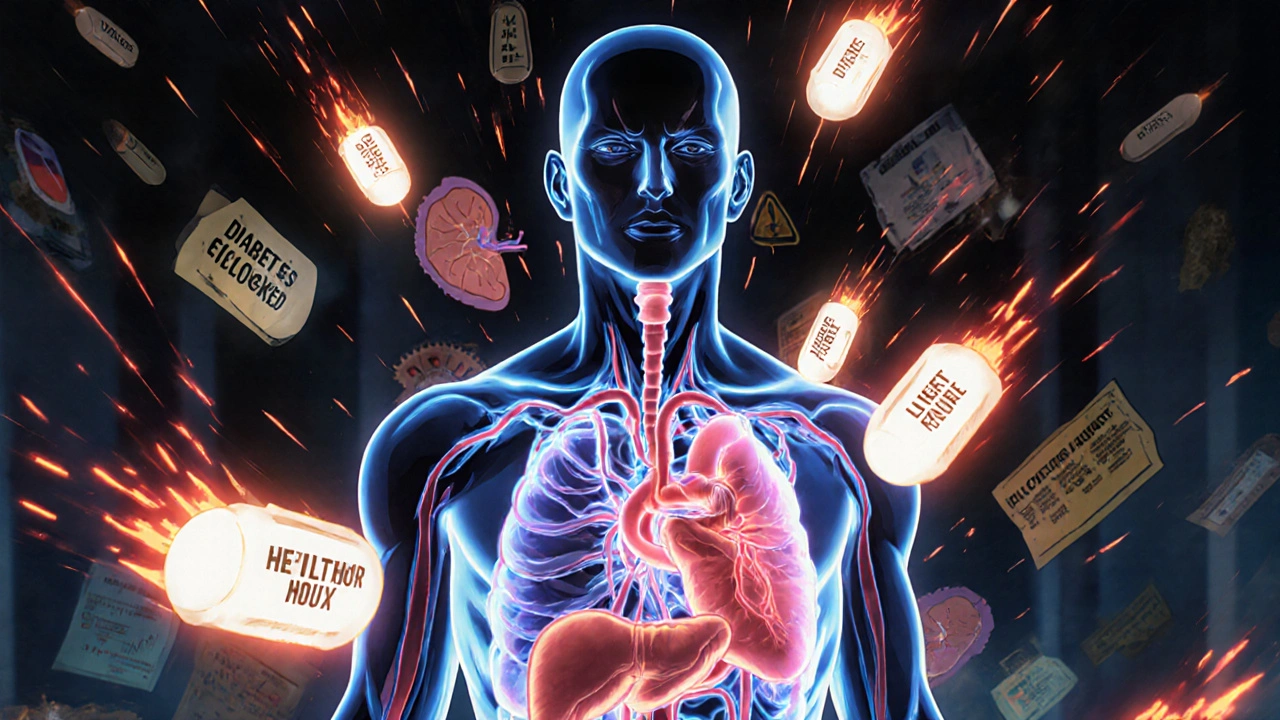Comorbidity Risk Checker
This tool provides general information about potential medication risks based on common medical knowledge. It is not a substitute for professional medical advice. Always consult your doctor or pharmacist about your specific medications and health conditions.
Results will appear here after checking your selections.
When you’re taking a prescription drug, you expect it to help. But if you have other health conditions - like diabetes, heart disease, kidney trouble, or chronic pain - that same drug can become a hidden danger. It’s not just about the medication itself. It’s about how your body, already under stress from other illnesses, reacts to it. This is where comorbidities turn ordinary side effects into serious risks.
Why Having More Than One Condition Makes Drugs More Dangerous
Most drug trials are done on healthy people or those with just one condition. But real life doesn’t work that way. In Australia, nearly 70% of adults over 65 have two or more chronic conditions. And that’s where the real danger begins. When you have multiple diseases, your body’s ability to handle drugs changes in ways doctors don’t always see on paper. Your liver might not break down medicines as well because of fatty liver disease. Your kidneys might not flush them out because of high blood pressure or diabetes. Even something as simple as dehydration from heart failure can make a drug stick around longer than it should. A major 2017 study found that patients with comorbidities were nearly three times more likely to have an adverse drug reaction than those without. That’s not a small risk. That’s a major red flag.What Happens in Your Body When You Have Comorbidities
Think of your body as a factory. Each organ has a job - liver processes drugs, kidneys filter them out, stomach absorbs them. When you have heart disease, your blood flow slows. That means drugs take longer to reach the liver. If you also have liver disease, that factory is already running at half capacity. Now the drug piles up. Too much. Too long. Renal impairment is another big one. If your kidneys aren’t filtering well - common in people with diabetes or high blood pressure - drugs like metformin, lithium, or certain antibiotics can build up to toxic levels. You might not feel it right away. But over time, that buildup can cause confusion, muscle weakness, or even kidney failure. Then there’s the pharmacodynamic side. Some conditions make your body more sensitive. Someone with Parkinson’s might develop severe tremors from a low dose of an antipsychotic that would be fine for someone else. An older person with osteoporosis might fall from mild dizziness caused by a blood pressure pill - and break a hip.The Polypharmacy Trap
It’s not just one drug. It’s five, seven, even ten. People with multiple conditions often take multiple medications. A 2019 study showed that elderly patients with several chronic illnesses take an average of 4.3 drugs daily. Nearly half take five or more. That’s where drug-drug interactions explode. One pill might raise your potassium. Another lowers it. One slows your heart. Another speeds it up. They cancel each other out - or worse, they stack up. In cancer patients, 65% of those on multiple drugs had at least one dangerous interaction. Over a third of those were major - meaning they could cause permanent damage or death. The most common symptoms? Weakness. Dizziness. Headaches. Nausea. These aren’t just annoyances. They’re warning signs. In people with comorbidities, dizziness leads to falls. Nausea leads to missed doses. Weakness leads to hospitalization.
High-Risk Comorbidities and Their Drug Traps
Some combinations are especially deadly.- Heart disease + NSAIDs: Painkillers like ibuprofen can raise blood pressure and strain the heart. For someone with heart failure, this can be dangerous.
- Diabetes + corticosteroids: Steroids spike blood sugar. For someone already struggling with insulin control, this can trigger diabetic ketoacidosis.
- Liver disease + sedatives: If your liver can’t process benzodiazepines, they build up. You might sleep for days. Or stop breathing.
- Depression + SSRIs + blood thinners: SSRIs can increase bleeding risk. Add warfarin or apixaban? That risk doubles.
- Chronic pain + opioids + alcohol: One in ten chronic pain patients misuses opioids. Add alcohol? Respiratory depression. Death.
Why Doctors Miss These Risks
It’s not that doctors don’t care. It’s that the system doesn’t help them see the full picture. Most patients with three or more conditions see five or more specialists. Each one writes a prescription. No one talks to the others. Your cardiologist doesn’t know your rheumatologist prescribed a steroid. Your pharmacist doesn’t know you’re taking herbal supplements for sleep. Plus, most clinical trials exclude people with multiple conditions. So the data on safety? It’s incomplete. Up to 80% of elderly patients with comorbidities were never studied before their drugs were approved. And time? Doctors spend an average of 15 minutes per visit. Reviewing five medications with complex interactions? Impossible.
How to Protect Yourself
You don’t have to accept this risk. Here’s what actually works:- Get a full medication review. Ask your GP or a clinical pharmacist to sit down with you and list every pill, patch, vitamin, and supplement you take - including over-the-counter stuff. This simple step reduces adverse reactions by 22%.
- Ask: “Is this still necessary?” Many drugs are prescribed years ago and never reviewed. Deprescribing - stopping unnecessary meds - cuts hospital visits by 17%.
- Use one pharmacy. This lets your pharmacist track all your drugs and catch interactions before they happen.
- Know your symptoms. If you feel unusually tired, dizzy, or confused after starting a new drug - don’t wait. Call your doctor. These aren’t just “side effects.” They’re your body screaming for help.
- Check for updated tools. New AI systems, like the NIH’s Comorbidity-Drug Interaction Knowledgebase, are now flagging 217 new dangerous combinations. Ask if your doctor uses a clinical decision support tool that checks for these.
The Future Is Personalized
The good news? Change is coming. New tools are now using your genetic data, lab results, and real-time health info to predict how you’ll react to a drug - not just based on age or diagnosis, but on your exact biology. Early trials show this approach cuts adverse reactions by 40%. Regulators are catching up too. Since 2021, 78% of new drug applications must include data on patients with comorbidities. That’s a big shift. By 2030, 90% of adults over 65 will have two or more chronic conditions. The old model - one disease, one drug - is broken. The future belongs to integrated care, smarter tech, and patients who know their risks.Bottom Line
Having multiple health conditions doesn’t mean you can’t take medication. But it does mean you need to be smarter about it. Every pill you take interacts with your body’s existing struggles. What’s safe for one person can be deadly for another. Don’t assume your doctor knows everything. Don’t assume your meds are harmless. Ask questions. Track your symptoms. Demand a full review. Your life might depend on it.Can comorbidities make side effects worse even if I’m not taking many drugs?
Yes. Even a single drug can become risky if your body is already stressed by chronic conditions. For example, someone with kidney disease may experience severe dizziness from a standard dose of a blood pressure pill because their kidneys can’t clear it properly. The problem isn’t the number of drugs - it’s how your body handles them.
Are over-the-counter medicines safe if I have comorbidities?
Not always. Many OTC drugs - like NSAIDs (ibuprofen, naproxen), antacids with aluminum, or sleep aids containing diphenhydramine - can be dangerous with heart, kidney, or liver disease. Always check with your pharmacist before taking anything new, even if it’s sold without a prescription.
Why do I get side effects now when I didn’t before?
Your body changes. As you age or develop new conditions, your liver and kidneys work less efficiently. Your metabolism slows. Your sensitivity to drugs increases. A dose that was fine five years ago may now be too strong. That’s why regular medication reviews are critical.
How do I know if a drug interaction is serious?
Look for sudden changes: confusion, fainting, irregular heartbeat, severe nausea, unexplained bruising, or extreme fatigue. These aren’t normal side effects - they’re red flags. If you notice them after starting or changing a medication, contact your doctor immediately. Don’t wait.
Can my pharmacist help me with drug interactions?
Absolutely. Pharmacists are trained to spot interactions across all your meds - including vitamins and supplements. If you use one pharmacy for all your prescriptions, they can track everything and warn you before a problem happens. Ask for a free medication review - it’s one of the most effective ways to stay safe.
Is there a tool I can use to check my own meds for risks?
Yes. Apps like Medscape, Micromedex, or the free Beers Criteria app from the American Geriatrics Society let you enter your meds and conditions to check for risks. But remember - these aren’t replacements for professional advice. Use them as a starting point, then talk to your doctor or pharmacist.
What if my specialist prescribes something new but my GP says it’s risky?
This is common. Ask your specialist to explain why the drug is necessary despite your other conditions. Request a consultation between your GP and specialist. Many hospitals now have medication reconciliation teams that do this. Don’t let conflicting advice go unresolved - your safety is at stake.





